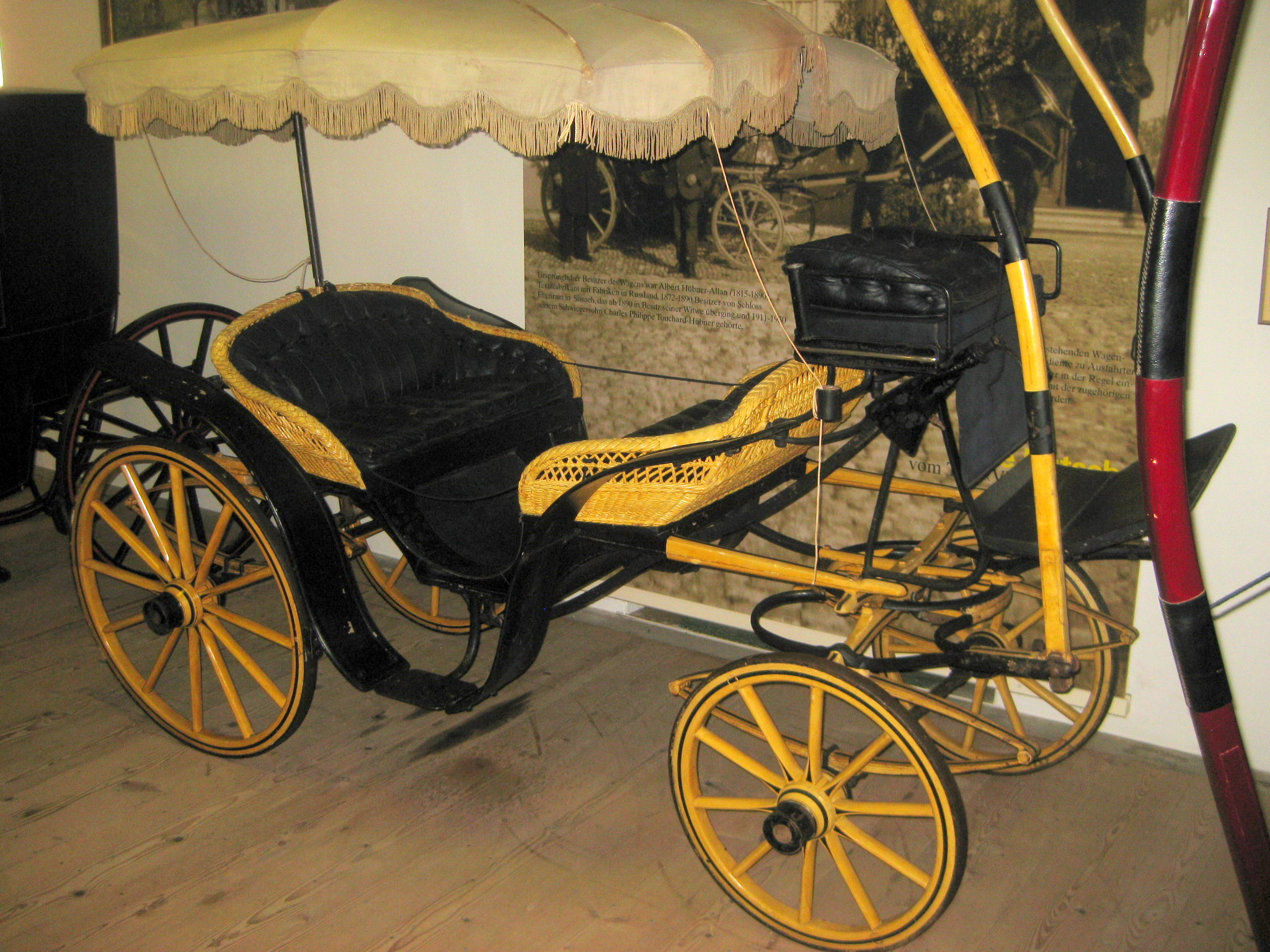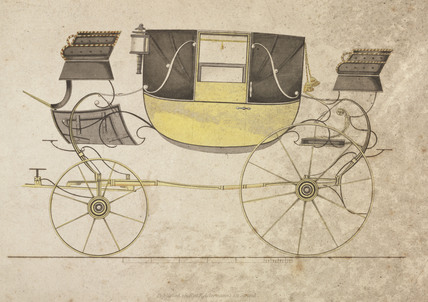|
Vis-à-vis (carriage)
__NOTOC__ A vis-à-vis is a carriage in which the passengers sit face to face with the front passengers facing rearward and the rear passengers facing forward. The term comes from the French ''vis-à-vis'', meaning face to face. These carriages are still commonly made by Amish carriage makers in the midwestern United States. Also in the Western world, the vis-a-vis is the most common type of carriage style used to cart tourists and leisure seekers in downtown urban settings. Passengers sit back-to-back on dos-à-dos carriages. Examples The following types of carriage had vis-à-vis seating: * Barouche * Berline * Landau Automobiles There were vis-à-vis automobiles in the early history of motoring. These were driven from the forward-facing rear seat, with front passengers sitting ahead of the steering controls and facing the driver. , page=484 Passengers in the front seat would obstruct the vision of the driver in the rear seat, and the style fell out of favour before 1905. ... [...More Info...] [...Related Items...] OR: [Wikipedia] [Google] [Baidu] |
Carriage
A carriage is a private four-wheeled vehicle for people and is most commonly horse-drawn. Second-hand private carriages were common public transport, the equivalent of modern cars used as taxis. Carriage suspensions are by leather strapping and, on those made in recent centuries, steel springs. Two-wheeled carriages are informal and usually owner-driven. Coaches are a special category within carriages. They are carriages with four corner posts and a fixed roof. Two-wheeled war chariots and transport vehicles such as four-wheeled wagons and two-wheeled carts were forerunners of carriages. In the twenty-first century, horse-drawn carriages are occasionally used for public parades by royalty and for traditional formal ceremonies. Simplified modern versions are made for tourist transport in warm countries and for those cities where tourists expect open horse-drawn carriages to be provided. Simple metal sporting versions are still made for the sport known as competitive driving. ... [...More Info...] [...Related Items...] OR: [Wikipedia] [Google] [Baidu] |
Karl Ludvigsen
Karl E. Ludvigsen (born April 24, 1934) is a journalist, author, and historian of the automotive industry and motor sports. Personal life Karl E. Ludvigsen was born on April 24, 1934 in Kalamazoo, Michigan. He was the son of Elliot "Lud" Ludvigsen, an engineer and executive of Eaton Corporation. Karl Ludvigsen has been resident in England since 1980 and lives in Suffolk with his wife Annette. Education He graduated Cum Laude from Phillips Exeter Academy, and attended both the Massachusetts Institute of Technology, studying engineering, and Pratt Institute where he matriculated in industrial design. Career Military service In 1958–59, he served in the US Army Signal Corps in West Germany. Automotive industry Ludvigsen worked as a designer at General Motors in 1956, Ludvigsen planned experimental front-drive prototypes. He also worked on the design and development of heavy-duty truck transmissions in the engineering and experimental departments of the Fuller Manufa ... [...More Info...] [...Related Items...] OR: [Wikipedia] [Google] [Baidu] |
French Language
French ( or ) is a Romance language of the Indo-European family. It descended from the Vulgar Latin of the Roman Empire, as did all Romance languages. French evolved from Gallo-Romance, the Latin spoken in Gaul, and more specifically in Northern Gaul. Its closest relatives are the other langues d'oïl—languages historically spoken in northern France and in southern Belgium, which French ( Francien) largely supplanted. French was also influenced by native Celtic languages of Northern Roman Gaul like Gallia Belgica and by the ( Germanic) Frankish language of the post-Roman Frankish invaders. Today, owing to France's past overseas expansion, there are numerous French-based creole languages, most notably Haitian Creole. A French-speaking person or nation may be referred to as Francophone in both English and French. French is an official language in 29 countries across multiple continents, most of which are members of the ''Organisation internationale de la Francophonie'' ... [...More Info...] [...Related Items...] OR: [Wikipedia] [Google] [Baidu] |
Amish
The Amish (; pdc, Amisch; german: link=no, Amische), formally the Old Order Amish, are a group of traditionalist Anabaptist Christian church fellowships with Swiss German and Alsatian origins. They are closely related to Mennonite churches, another Anabaptist denomination. The Amish are known for simple living, plain dress, Christian pacifism, and slowness to adopt many conveniences of modern technology, with a view neither to interrupt family time, nor replace face-to-face conversations whenever possible, and a view to maintain self-sufficiency. The Amish value rural life, manual labor, humility and '' Gelassenheit'' (submission to God's will). The history of the Amish church began with a schism in Switzerland within a group of Swiss and Alsatian Mennonite Anabaptists in 1693 led by Jakob Ammann. Those who followed Ammann became known as Amish. In the second half of the 19th century, the Amish divided into Old Order Amish and Amish Mennonites; the latter do not abstain fr ... [...More Info...] [...Related Items...] OR: [Wikipedia] [Google] [Baidu] |
Midwest (US)
The Midwestern United States, also referred to as the Midwest or the American Midwest, is one of four census regions of the United States Census Bureau (also known as "Region 2"). It occupies the northern central part of the United States. It was officially named the North Central Region by the Census Bureau until 1984. It is between the Northeastern United States and the Western United States, with Canada to the north and the Southern United States to the south. The Census Bureau's definition consists of 12 states in the north central United States: Illinois, Indiana, Iowa, Kansas, Michigan, Minnesota, Missouri, Nebraska, North Dakota, Ohio, South Dakota, and Wisconsin. The region generally lies on the broad Interior Plain between the states occupying the Appalachian Mountain range and the states occupying the Rocky Mountain range. Major rivers in the region include, from east to west, the Ohio River, the Upper Mississippi River, and the Missouri River. The 2020 United ... [...More Info...] [...Related Items...] OR: [Wikipedia] [Google] [Baidu] |
Western World
The Western world, also known as the West, primarily refers to the various nations and state (polity), states in the regions of Europe, North America, and Oceania.Western Civilization Our Tradition; James Kurth; accessed 30 August 2011 The Western world is also known as the Occident (from the Latin word ''occidēns'' "setting down, sunset, west") in contrast to the Eastern world known as the Orient (from the Latin word ''oriēns'' "origin, sunrise, east"). Following the Discovery of America in 1492, the West came to be known as the "world of business" and trade; and might also mean the Northern half of the North–South divide, the countries of the ''Global North'' (often equated with capitalist Developed country, developed countries). [...More Info...] [...Related Items...] OR: [Wikipedia] [Google] [Baidu] |
Dos-à-dos (carriage)
A dogcart (or dog-cart) is a light horse-drawn vehicle, originally designed for sporting shooters, with a box behind the driver's seat to contain one or more retriever dogs. The dog box could be converted to a second seat. Later variants included : * A one-horse carriage, usually two-wheeled and high, with two transverse seats set back to back. It was known as a "bounder" in British slang (not to be confused with the cabriolet of the same name). In India it was called a "tumtum" (possibly an altered form of "tandem"). * A French version having four wheels and seats set back to back was a ''dos-à-dos'' (French for "back-to-back"). * An American four-wheeled dogcart, having a compartment for killed game, was called a "game cart". A young or small groom called a "tiger" might stand on a platform at the rear of a dogcart, to help or serve the driver. Frequent references to dog-carts are made by Sir Arthur Conan Doyle in his writings about fictional detective Sherlock Holmes, [...More Info...] [...Related Items...] OR: [Wikipedia] [Google] [Baidu] |
Barouche
A barouche is a large, open, four-wheeled carriage, both heavy and luxurious, drawn by two horses. It was fashionable throughout the 19th century. Its body provides seats for four passengers, two back-seat passengers vis-à-vis two behind the coachman's high box-seat. A leather roof can be raised to give back-seat passengers some protection from the weather. Etymology ''Barouche'' is an anglicisation of the German word ''barutsche'', via the Italian ''baroccio'' or ''biroccio'' and ultimately from the ancient Roman Empire's Latin ''birotus'', "two-wheeled". The name thus became a misnomer, as the later form of the carriage had four wheels. Development and variations The barouche was based on an earlier style of carriage, the ''calash'' or ''calèche'': this was a light carriage with small wheels, inside seats for four passengers, a separate driver's seat and a folding top. A folding calash top was a feature of two other types: the chaise, a two-wheeled carriage for one or two ... [...More Info...] [...Related Items...] OR: [Wikipedia] [Google] [Baidu] |
Berlin (carriage)
A Berlin (or Berline) carriage was a type of covered four-wheeled travelling carriage with two interior seats. Initially noted for using two chassis rails and having the body suspended from the rails by leather straps, the term continued in use for enclosed formal carriages with two seats after the Suspension (vehicle), suspension system changed from leather straps to steel springs. Origin The carriage was designed around 1660 or 1670 by a Piedmontese architect commissioned by the General quartermaster to Frederick William, Elector of Brandenburg. The Elector used the carriage to travel from Berlin, Margraviate of Brandenburg, Brandenburg's capital, to the French capital of Paris, a distance of where his carriage created a sensation. While heavy-duty vehicles had used double-railed frames before, passenger vehicles had normally used a single rail. The elegant but durable style was widely copied and named "berline" after the city from which the carriage had come. It was more conv ... [...More Info...] [...Related Items...] OR: [Wikipedia] [Google] [Baidu] |
Landau (carriage)
In coachbuilding, a landau is a four-wheeled carriage with a roof that can be let down. It was a luxury carriage. The low shell of the landau provides maximal visibility of the occupants and their clothing, a feature that makes a landau still a popular choice for Lord Mayors in the United Kingdom on ceremonial occasions. History of landau carriages A landau is lightweight and suspended on elliptical springs. It was invented in the 18th century; ''landau'' in this sense is first noted in English in 1743. It was named after the German city of Landau in the Rhenish Palatinate where they were first produced. In the 1830s, Luke Hopkinson, a celebrated coach-maker in Holborn, introduced the Briska Landau, which led with subsequent improvements to the popular landau. Description and development A landau, drawn by a pair or four-in-hand, is one of several kinds of vis-à-vis, a social carriage with facing seats over a dropped footwell (''illustration''), which was perfected by ... [...More Info...] [...Related Items...] OR: [Wikipedia] [Google] [Baidu] |
Teste & Moret 1902
A testicle or testis (plural testes) is the male reproductive gland or gonad in all bilaterians, including humans. It is homologous to the female ovary. The functions of the testes are to produce both sperm and androgens, primarily testosterone. Testosterone release is controlled by the anterior pituitary luteinizing hormone, whereas sperm production is controlled both by the anterior pituitary follicle-stimulating hormone and gonadal testosterone. Structure Appearance Males have two testicles of similar size contained within the scrotum, which is an extension of the abdominal wall. Scrotal asymmetry, in which one testicle extends farther down into the scrotum than the other, is common. This is because of the differences in the vasculature's anatomy. For 85% of men, the right testis hangs lower than the left one. Measurement and volume The volume of the testicle can be estimated by palpating it and comparing it to ellipsoids of known sizes. Another method is to use calipers ... [...More Info...] [...Related Items...] OR: [Wikipedia] [Google] [Baidu] |




.jpg)

_by_shakko.jpg)

